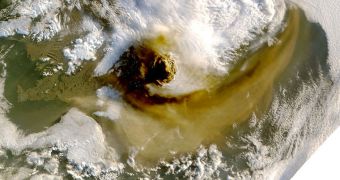The 2010 eruption of the Eyjafjallajökull Volcano and the 2011 eruption of the Grímsvötn Volcano both spread massive ash plumes in the air, forcing flights and passengers to remain grounded. But these events were just a “taste” of the eruptions that lie in store for out planet.
This conclusion belongs to a new study, which is detailed in the book “Eruptions That Shook The World,” published by Cambridge University Press. The work was authored by Dr. Clive Oppenheimer, who is a volcanologist at the University o Cambridge, in the United Kingdom.
In the future, even bigger eruptions might take a catastrophic toll on the planet, the expert writes. He says that the ash clouds produced by the two Iceland volcanoes over the past 2 years were small compared to what Earth is capable of producing.
Millions of years ago, supervolcanoes managed to emit so much ash, that they covered the entire planet in a thick layer of smoke, dropping temperatures considerably, bringing about ice ages, and wiping numerous species off the face of the planet.
Today, we are relatively safe from that, with the exception of the Yellowstone Caldera, the only remaining, active supervolcano in the world. But other volcanoes are capable of causing a great deal of mischief on their own.
When Eyjafjallajökull blew up, international air traffic was paralyzed, and billions of dollars were lost. The ash cloud spread over Europe like a funeral shroud, but dissipated within a few months. In the future, other clouds might not be so quick to disperse.
“What we need is a reality check – a forensic test to see how far claims about catastrophes changing the world really hold up. There is a lot to learn about volcanoes and they affect our lives in so many ways, even if we don’t live near one,” Oppenheimer explains.
“The Japanese earthquake, tsunami and knock-on effects at the Fukushima nuclear plant shows that cascading failures can have massive impacts on societies,” the author argues, mentioning that 12 major cities and 10 percent of the world's population are now located in the range of active volcanoes.
“The problem for governments is that the potential scale of the damage that really big eruptions cause is difficult to consider against the improbability of them occurring,” Oppenheimer explains.
“We need effective tools for making informed decisions about how to prepare. This means deducing as much as we can from past eruptions,” he argues. Over the course of history, millions died from starvation caused by crop failure.
This is one of the most common effects of volcanic eruptions. “As the global population heads towards 10 billion, the human track record shows that we can manage the consequences of eruptions with resolve, flexibility and creativity – if we prepare properly,” Oppenheimer concludes.

 14 DAY TRIAL //
14 DAY TRIAL //